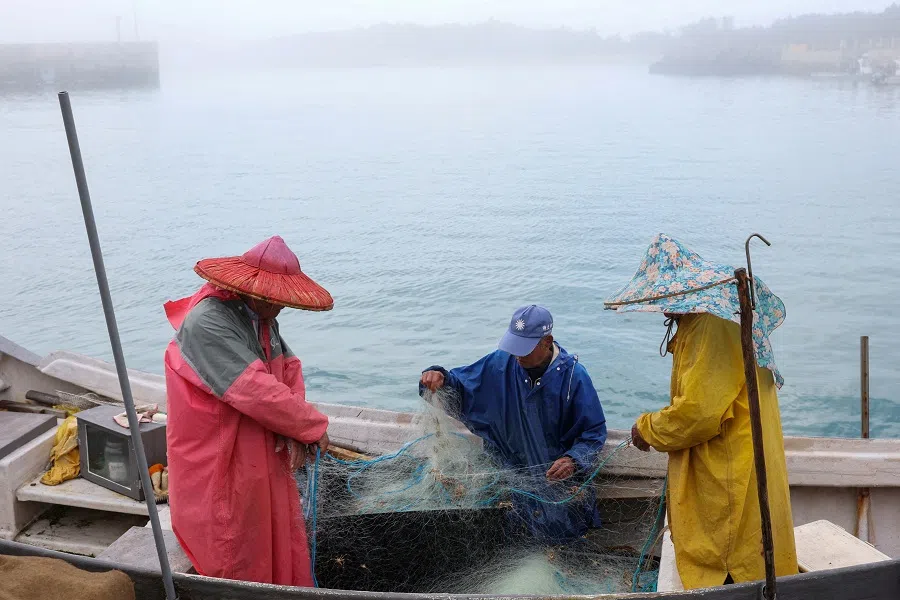Likelihood of crises in Taiwan Strait rises as 'grey areas' disappear
US academic Zhu Zhiqun observes that the ambiguity and grey areas created through tacit understanding among Beijing, Taipei and Washington have long helped sustain the Taiwan Strait peace and prosperity. Once these grey areas fall apart, the fragile stability in the Taiwan Strait could be broken, leading to crises.

The recent tragedy in the Taiwan Strait that led to the death of two Chinese fishermen in the waters near Taiwan-controlled Kinmen is another wake-up call that cross-strait relations are delicate and volatile, and if tacit agreements and grey areas across the Taiwan Strait disappear, crises may ensue.
In August 2022, then Speaker of the US House of Representatives Nancy Pelosi, snubbing warnings from Beijing and dissuasions from many in the US, insisted on visiting Taiwan. The Democratic Progressive Party (DPP) government in Taipei warmly welcomed such a high-level visit from a top US leader. As expected, Beijing strongly condemned Washington and Taipei for upgrading the so-called "unofficial" US-Taiwan relations and challenging the "one China" policy.
Pelosi's visit and the PLA's response led to the end of such tacit agreement and practices.
The disappearing 'median line'
As soon as Pelosi left Taiwan, the People's Liberation Army (PLA) held large-scale military exercises at multiple locations around Taiwan, simulating a blockade of Taiwan. The most striking development was that the PLA aircraft openly crossed the "median line" of the Taiwan Strait. A "new normal" has been established since then, with the PLA aircraft flying across this virtual dividing line almost daily.
In response to reporters' questions regarding Pelosi's Taiwan visit, Chinese Vice-Foreign Minister Ma Zhaoxu emphasised that Taiwan is part of China's territory and there is no "median line of the strait" at all. This grey area across the Taiwan Strait that has helped maintain the status quo vanished.
The "median line of the strait" is not an actual line, but it has played a buffering role for the currently divided two sides of the Taiwan Strait. From 1949 to the early 1990s, Taiwan's Air Force maintained air superiority over the Taiwan Strait, and Taiwan's military aircraft frequently crossed this so-called median line and even flew close to the coast of the Chinese mainland. Since the mid-1990s, the military strength has gradually tilted towards the mainland as the PLA's naval and air forces continued to grow. Under these circumstances, the two sides formed a tacit understanding that their respective military aircraft and warships would only operate on their side of the Taiwan Strait. They regard this virtual line as the de facto border and do not challenge the other party's actual control. Pelosi's visit and the PLA's response led to the end of such tacit agreement and practices.
Mainland no longer honours the grey area around Kinmen
The waters of Kinmen and Xiamen are connected and are a common space for fishermen from both sides. When cross-strait relations are stable, the so-called "trespassing fishing" is not viewed as a big problem. Now cross-strait relations are tense, everything becomes complicated.
The DPP government insisted that the mainland fishing boat entered Kinmen's "prohibited and restricted waters" during the 2024 Lunar New Year holiday and that the Taiwan Coast Guard carried out the eviction operation in accordance with the law. Taiwan's Coast Guard vessel hit the mainland fishing boat during the chase, leading to the boat's capsizing that drowned two mainland fishermen.
... the Chinese Coast Guard began patrolling the area, suggesting that the mainland no longer honours the grey area around Kinmen.

China's Taiwan Affairs Office spokeswoman Zhu Fenglian stated that since both sides of the Taiwan Strait belong to one China, there is no such thing as "prohibited or restricted waters". A few days later, the Chinese Coast Guard began patrolling the area, suggesting that the mainland no longer honours the grey area around Kinmen.
Abandoning the '1992 Consensus'
The biggest grey area between the two sides is the "1992 Consensus", according to which both insist on "one China" without clearly defining it. This is a wise move for both sides to respect history and reality while not challenging the status quo.
It is this ambiguity or grey area that has brought peace and tangible benefits to both sides, such as during the Ma Ying-jeou administration (2008-2016) when both sides recognised the 1992 Consensus. Now that the 1992 Consensus has been abandoned by the DPP government, the basis for cross-strait cooperation no longer exists, leading to growing distrust and tensions.
By ditching the 1992 Consensus, the DPP government has attempted to unilaterally change the status quo. It claims that the two sides of the Taiwan Strait are not subordinate to each other and are two separate countries, contradicting its own promise to abide by the Republic of China Constitution which views both sides as part of the same country. As tacit agreements and grey areas disappear, the likelihood of conflicts and crises in the Taiwan Strait has risen.
In late February 2024, a bipartisan delegation of US lawmakers led by the House Select Committee on Chinese Communist Party leaders Mike Gallagher (Republican-Wisconsin) and Raja Krishnamoorthi (Democrat-Illinois) visited Taipei, reiterating "rock-solid" US support for Taiwan. While the visit was welcomed by Taipei, Beijing slammed it as violating US-China agreements on "one China".
Ignoring grey areas would be catastrophic
High-profile visits to Taiwan by US members of Congress and government officials are symbolic, underscoring US support for Taiwan's democracy and security. Though such gestures help boost Taiwan's confidence, they may weaken Taipei's desire to seek rapprochement with Beijing.
As a result, the DPP government continues to pursue a policy of "relying on America and confronting China" instead of striking some balance between the two great powers. With US-China competition intensifying, the Beijing-Washington-Taipei triangular relationship will remain very unstable, even dangerous, in the years ahead.
If they are ignored, the contradictions and problems in Taipei-Beijing-Washington relations will be exposed, and fragile stability in the Taiwan Strait will be broken, leading to crises.

The complex relationship across the Taiwan Strait requires some imagination and flexibility to maintain. The ambiguity and grey areas created through tacit understanding among Beijing, Taipei and Washington have long helped sustain the Taiwan Strait peace and prosperity. If they are ignored, the contradictions and problems in Taipei-Beijing-Washington relations will be exposed, and fragile stability in the Taiwan Strait will be broken, leading to crises.
Recent developments in the Taiwan Strait suggest that to maintain peace and stability in the Taiwan Strait, it takes all stakeholders to act responsibly. Departing from shared understanding, especially tacit agreement on "one China", is a recipe for potential disasters.



![[Big read] Love is hard to find for millions of rural Chinese men](https://cassette.sphdigital.com.sg/image/thinkchina/16fb62fbcf055b710e38d7679f82264ad682ce8b45542008afeb14d369a94399)
![[Big read] China’s 10 trillion RMB debt clean-up falls short](https://cassette.sphdigital.com.sg/image/thinkchina/d08cfc72b13782693c25f2fcbf886fa7673723efca260881e7086211b082e66c)
